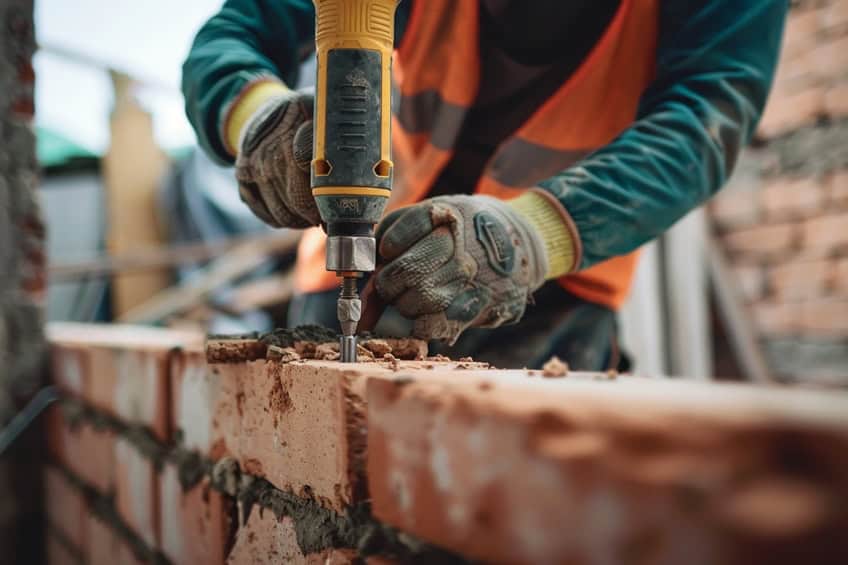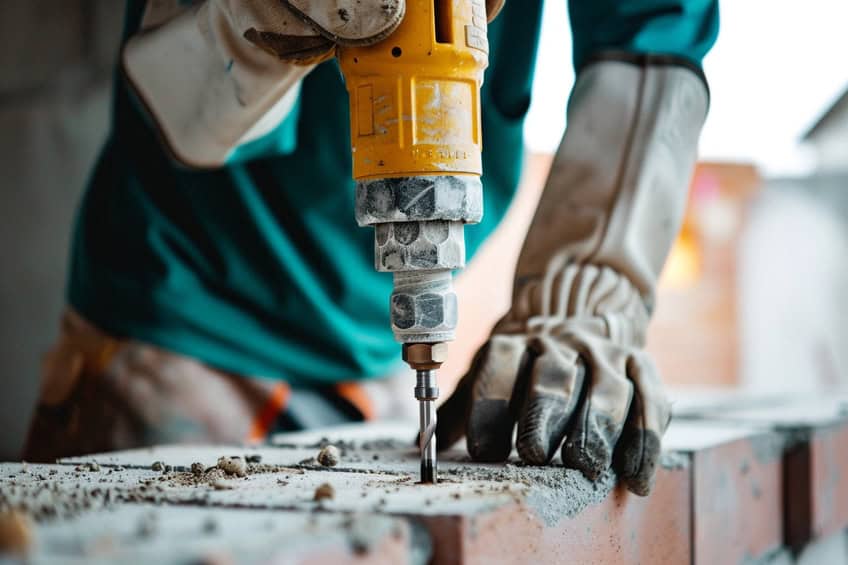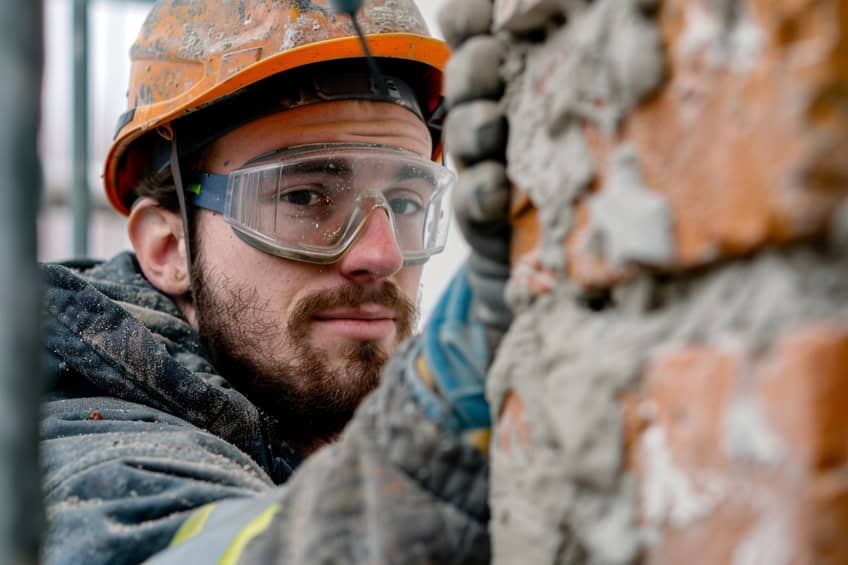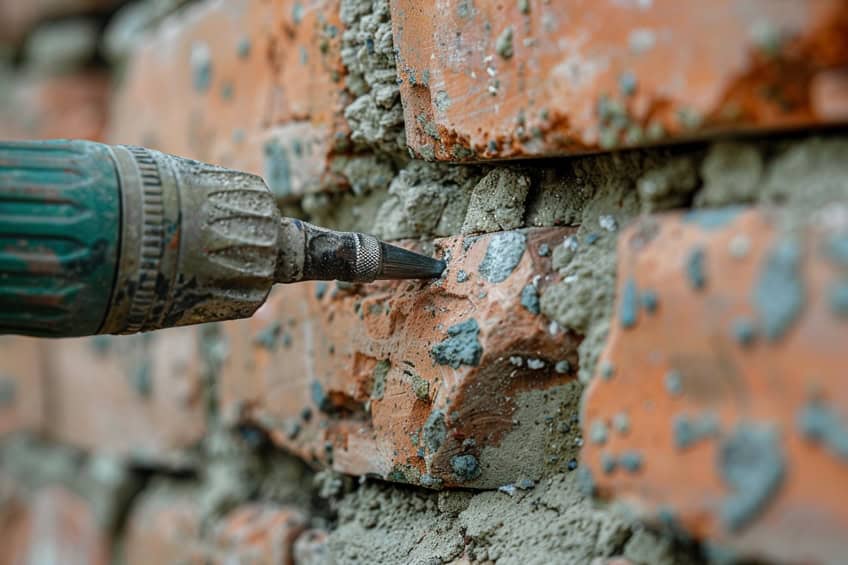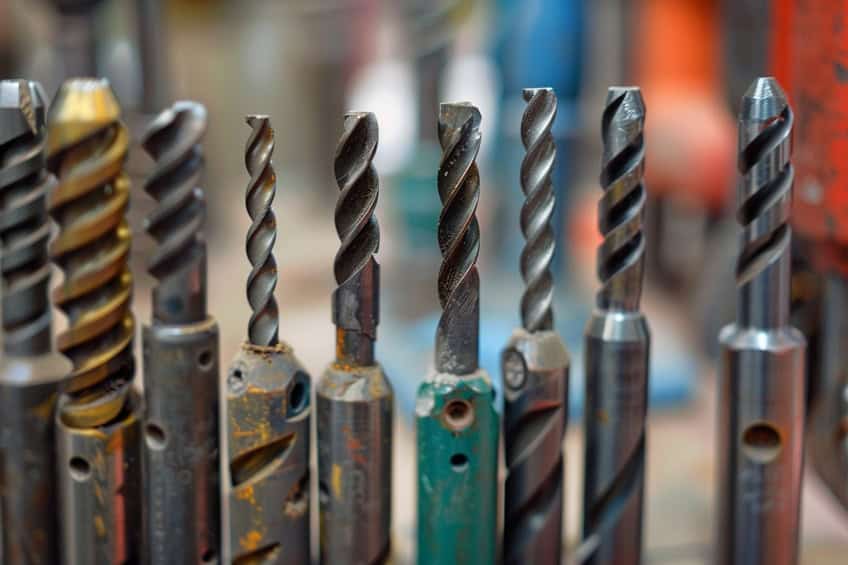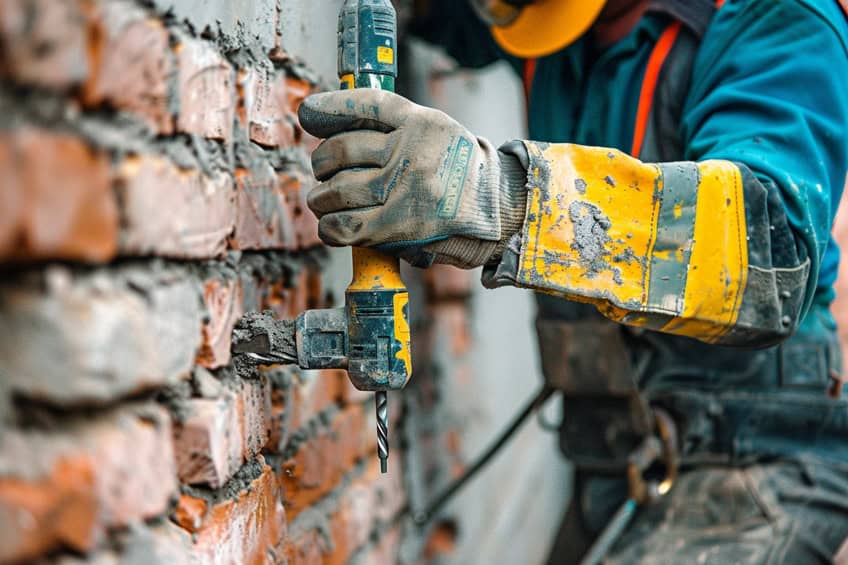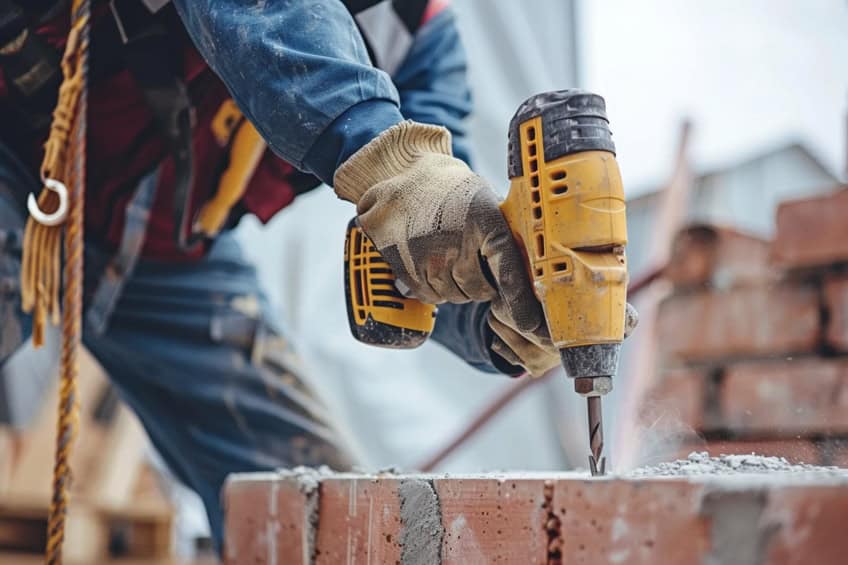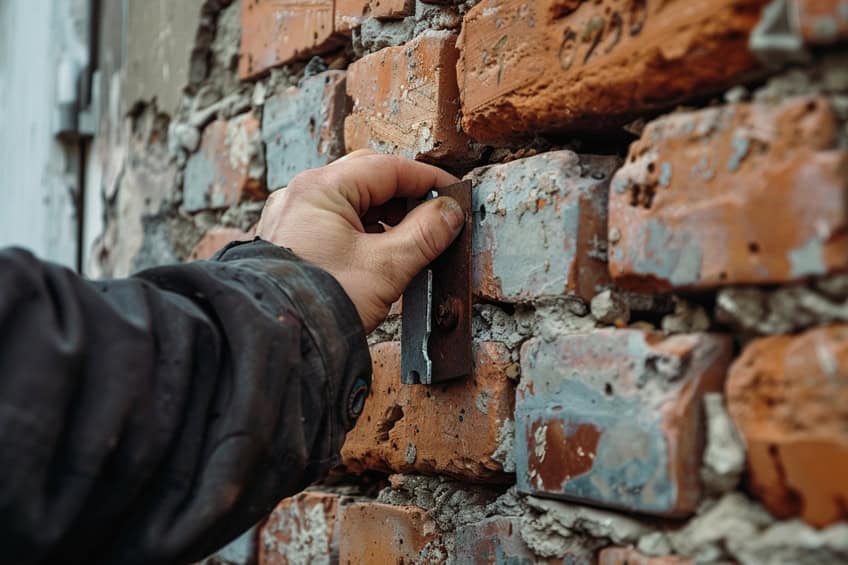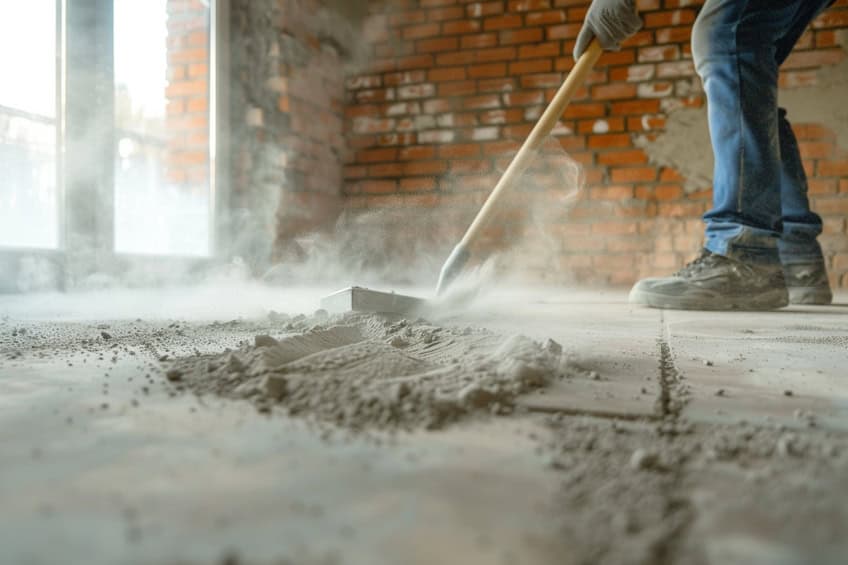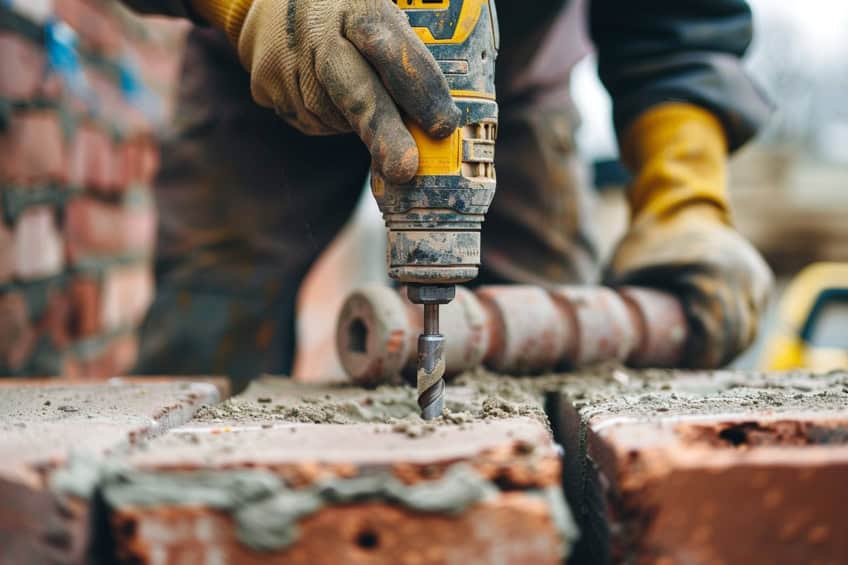How to Drill into Brick – Tools of the Trade
This post may contain affiliate links. We may earn a small commission from purchases made through them, at no additional cost to you. You help to support resin-expert.com
Drilling into brick may seem like a daunting task, but fear not, DIY enthusiast! With the right tools and techniques, you can turn that solid brick wall into a canvas for your home improvement dreams. Whether you’re hanging up a shelf, installing outdoor lights, or adding decorative touches, drilling into brick opens up a world of possibilities. So grab your safety goggles, dust off that power drill, and let’s dive into the art of drilling into brick like a pro!
Table of Contents
Key Takeaways
- Use the correct type of masonry drill bit and hammer drill for effective results.
- Thorough preparation and accurate marking are key for precise drilling.
- Steady execution with even pressure and post-drilling clean-up are essential.
Preparing to Drill into Brick
Drilling into brick is a task that may seem daunting but is quite manageable with the right tools and techniques. Brick, being a hard material, requires particular attention to the type of drill and drill bit used. It’s important to approach the task methodically to ensure a clean hole and to maintain the structural integrity of the brick. Before beginning, the area where drilling is to take place should be clearly marked and prepared. Securing the correct type of masonry bit and a strong drill, typically a hammer drill, is essential.
Preparing the work area by cleaning the brick surface and ensuring that the drill point is precisely marked can make the project run smoother.
Ensuring safety measures and appropriate handling of tools is also an important part of the preparation. Executing the drilling requires a steady, firm hand and a paced approach to apply even pressure. Once the drilling is complete, installing whatever fixtures are needed must be done with care, and the clean-up process ensures that the area is left tidy and any dust or debris is removed. Understanding what to do when complications arise or knowing why a drill may not penetrate a brick wall is also crucial for problem-solving during such tasks.
Safety First
Before one starts, it is essential to prioritize safety. Wearing safety glasses or goggles is critical to protect one’s eyes from brick dust and debris. The use of an N95 respirator or dust mask can safeguard against the inhalation of fine particles. Additionally, considering hearing protection with earplugs is advisable due to the potential noise from a hammer drill.
Selecting the Right Tools
The selection of a hammer drill is ideal when working with brick because of its hammer function that facilitates the drilling process. The use of a masonry drill bit that matches the desired hole size is necessary. These drill bits are specifically designed to penetrate tough materials like brick without causing damage to the material or the tools.
Deciding Where to Drill
Determining the exact location for drilling is a step that requires precision. One should avoid areas with visible cracks or damages in the brick. Using a ladder safely is recommended if the drilling location is beyond reach. This will provide stable support and allow for accurate drilling.
Measure and Mark
The final step in preparation involves measuring and marking the precise spot where the hole will be made. A measuring tape and a pencil are the simple but crucial tools for this task. If drilling multiple holes, a bubble level is essential to ensure alignment and straightness. Marks should be clear and visible to guide the drilling process.
Once marked, a light tap with a hammer can indent the brick slightly, allowing the masonry bit to stay in place when drilling starts.
What Drill Bit Should Be Used for Drilling into Brick?
When drilling into brick, one must ensure that they use the right drill bit for efficient and safe work. It’s crucial to match the drill bit to the hardness and density of the brick to avoid damage to both the brick and the drill bit itself.
Different Drill Bits
One should select a drill bit that is long enough to penetrate the brick fully. The diameter of the drill bit also needs to be appropriate for the size of the hole required. Regular checks for wear and damage can ensure safety and effectiveness during the drilling process.
- Masonry drill bits: These are the most common choice for drilling into brick. Featuring a tungsten carbide tip, they are specifically designed to cut through hard materials.
- Hammer drill bits: For use with a hammer drill, these bits excel in the percussion drilling method, chipping away brick while rotating.
- Rotary drill bits: Suitable for drilling lighter bricks or for occasional use, these can work without a hammer action.
- Diamond drill bits: These are optimal for creating precise holes in tougher bricks, but they require a specific drilling setup and are often more expensive.
Drilling Technique and Execution
When drilling into brick, precision and proper execution are vital. One should employ the right technique to ensure a clean hole and avoid damage to the brick surface.
Pilot Hole
The initial step is to create a pilot hole, which guides subsequent drilling. One should use a masonry bit that is smaller than the intended screw size for this task. It is essential to position the drill bit at the marked spot on the brick wall and start at a low speed to gain control and accuracy.
The drill should be held steady, and even pressure should be applied to create a pilot hole.
- Marking the spot: Use a pencil or marker to precisely indicate where the pilot hole will go.
- Masonry bit selection: Choose a masonry bit that is 1-2 sizes smaller than the screw diameter.
- Starting the drill: Begin at a low speed to prevent the bit from wandering.
Drilling the Hole
Once the pilot hole is established, the user can switch to the actual size masonry bit. In the case of a rotary hammer drill or hammer drill, set the device to hammer mode for efficient drilling into brick. One should maintain a steady pressure and let the drill do the work rather than forcing it. Here are specific steps one should follow:
- Bit selection: Select the correct size masonry bit based on the screw’s diameter.
- Drilling into brick vs. mortar: Opt to drill into mortar for less structural impact, but if drilling into brick is necessary, ensure that the drill is perpendicular to the surface.
- Speed management: Keep the speed low to moderate to minimize overheating.
- Cooling the bit: Occasionally withdraw the drill bit to remove debris and allow it to cool.
When handling the drill, users should ensure that they maintain a secure grip and posture to manage the power tool effectively. After drilling to the desired depth, the user should clear out any residual dust or debris from the hole and the surrounding area, ensuring a clean environment for placing screws or anchors.
Installing Fixtures and Cleaning Up
After successfully drilling into brick, the next crucial steps involve securely installing the fixture and ensuring a thorough cleanup. These final stages are essential to provide a polished look and maintain the integrity of the work area.
Securing Wall Anchors and Screws
When installing shelves or cabinets, it is pivotal to use the correct size wall anchors and screws for the weight of the item being hung. Firstly, insert the anchor into the drilled hole, tapping it gently with a hammer if necessary. Then, using a screwdriver, drive the screw into the anchor, leaving enough of the screw exposed to hang the item. Ensure that the wall anchor fits snugly and that the screw is fastened securely to support the weight of the fixture.
- Tools required: A hammer and screwdriver.
- Steps: Insert the wall anchor into the hole. Secure the screw into the anchor with a screwdriver.
Sealing Holes With Putty
Any gaps or misdrilled holes in the brick veneer should be filled to prevent damage from moisture or pests. Use a color-matched putty to seal the holes and maintain the aesthetic of the brickwork. Apply the putty with a putty knife and smooth it over for a seamless finish.
- Materials needed: Color-matched putty and a putty knife.
- Application: Fill the hole with putty using a putty knife. Smooth out the surface for a clean finish.
Post-Drilling Cleanup
It’s imperative for safety and cleanliness to tidy up the debris created while drilling. A shop vacuum or vacuum cleaner should be used to clean the hole and immediate area thoroughly. Additionally, a broom and dustpan or mop might be necessary for larger brick particles. Removing all dust and debris ensures a clean space for both the installer and the homeowner.
- Cleanup tools: Shop vacuum or vacuum cleaner, a broom and dustpan, and a mop (for larger debris).
- Procedure: Vacuum around the drilled hole and workspace. Sweep up any residual dust. Mop if necessary to remove fine particles.
Why Can’t I Drill into My Brick Wall?
When someone finds it challenging to drill into a brick wall, several factors may be at play. Firstly, the wrong drill bit may be the issue. A masonry drill bit is specifically designed for brick and stone. Using a metal or wood drill bit, which is not tough enough for masonry, will impede progress and may even cause the bit to snap. Suboptimal drill settings can also hinder drilling into brick. A drill should be set to a hammer function if available, and started at a low speed to prevent overheating. Gradually increasing speed prevents damage both to the drill bit and the brick.
Another common problem is dull drill bits. Even a masonry bit can wear out over time, making it less effective.
A sharp bit is essential for efficient drilling into hard materials like brick. Debris in the hole can halt drilling progress. As one drills, brick dust accumulates and may block the drill bit from advancing. Regularly clearing the hole of debris is necessary. Lastly, drilling into a mortar joint rather than the brick itself is often easier because the mortar is softer. However, for heavy items, drilling into the brick provides more support. Understanding these factors helps in diagnosing why a drill may not penetrate a brick wall and guides users toward the right solutions.
Now that you’ve mastered the art of drilling into brick, you’re ready to tackle any project with confidence and precision. Remember to always prioritize safety by wearing protective gear and using the right tools for the job. Whether you’re a seasoned DIY pro or just starting out, the satisfaction of seeing your creations come to life on a sturdy brick wall is unparalleled. So go ahead, unleash your creativity, and let those bricks be the foundation of your DIY success story!
Frequently Asked Questions
What Are the Best Techniques for Drilling into Brick Without Causing Cracks?
To prevent cracking while drilling into brick, one should begin with a small, sharp drill bit and progress to larger sizes. It’s advisable to keep the drill bit cool and the brick slightly damp, as a lubricated and cool surface reduces the likelihood of cracks.
Can You Use a Regular Drill When Working With Brick, or Is a Special Tool Required?
A regular drill can be used for brickwork; however, a hammer drill is preferable. The hammering action of a hammer drill makes it more efficient at penetrating masonry materials like brick without causing undue stress that could lead to cracking or damage.
How Do You Select the Appropriate Drill Bit for Brick?
The appropriate drill bit for brick is a masonry bit, which is typically made of tougher material such as carbide. Masonry bits are designed to handle the hardness of brick and provide cleaner holes. The bit size should match the desired hole size and the type of anchor or screw being used.
What Is the Ideal Speed to Maintain When Drilling into Brick to Prevent Damage?
The ideal speed when drilling into brick will vary depending on the drill bit size and the drill’s power. Generally, a low to medium speed is recommended to prevent overheating of the bit and to maintain control, which helps in preventing brick damage.


